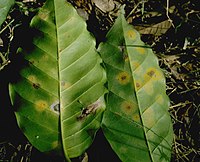
Photo from wikipedia
Uromyces is the second-largest plant pathogenic rust genus, is responsible for numerous diseases, and has major effects on both agricultural and non-agricultural plants. The genus is generally characterized by its… Click to show full abstract
Uromyces is the second-largest plant pathogenic rust genus, is responsible for numerous diseases, and has major effects on both agricultural and non-agricultural plants. The genus is generally characterized by its unicellular teliospores that help to characterize it and distinguish it from another important rust genus, Puccinia. In this study, a global overview of the diversity and distribution of Uromyces is presented based on both online and offline resources. The information obtained was analyzed for numerical and graphical summaries to provide the diversity and distribution of the genus by country and continent. Besides this, broad taxonomical aspects, a brief life cycle, and other comparative aspects on diversity and distribution were also provided. In addition, a phylogenetic analysis based on the ITS and nLSU DNA sequence data available in GenBank and published literature was performed to examine the intergeneric relationships of Uromyces. The results obtained revealed that the rust genus is found distributed over 150 countries, territories, and occupancies of the world on around 647 plant genera belonging to 95 plant families. Phylogenetic studies based on LSU and ITS sequence data revealed that Uromyces species are polyphyletic and require more DNA-based analyses for a better understanding of their taxonomic placement.
Journal Title: Journal of Fungi
Year Published: 2022
Link to full text (if available)
Share on Social Media: Sign Up to like & get
recommendations!